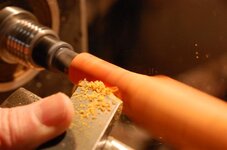I'm playing around with CA finish - the first few I did, I sanded to 400 and then applied CA and wet micro meshed followed by plastic polish and the results were very nice.
On some woods - redheart for example - I found that after I applied the CA, I could see scratches left by the 400, and then had to sand off the CA back to 320, then 400 and then 600 (I don't have and paper in stock past 400 except some wet/dry 600 emery) and do the CA again.
[I'm using thin CA only not CA and BLO]
I'm trying to get a reasonably good CA finish with cheaper pen kits - to keep the finished product cost down and reduce labor time.
On some woods - redheart for example - I found that after I applied the CA, I could see scratches left by the 400, and then had to sand off the CA back to 320, then 400 and then 600 (I don't have and paper in stock past 400 except some wet/dry 600 emery) and do the CA again.
[I'm using thin CA only not CA and BLO]
I'm trying to get a reasonably good CA finish with cheaper pen kits - to keep the finished product cost down and reduce labor time.

